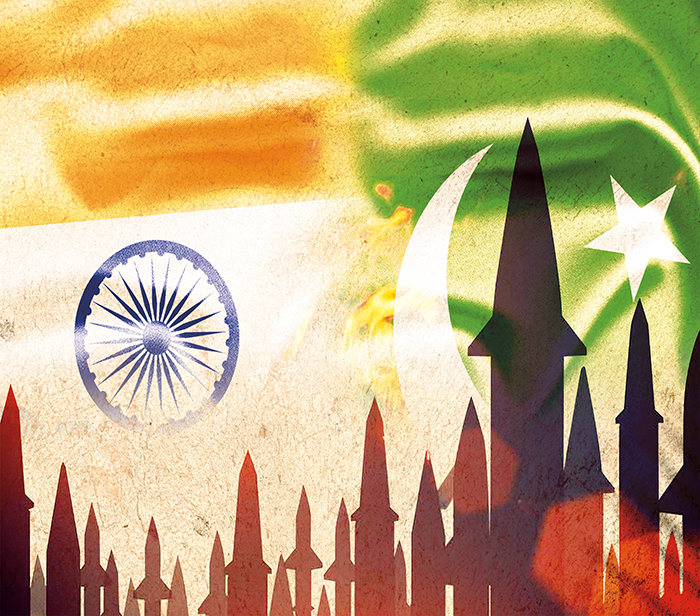
Hannah Haegeland
The current state of affairs in Kashmir and resulting heightening of India-Pakistan tensions provide daily examples of escalation risks. Since 1998, the low-probability, high-cost risk of escalation across the nuclear threshold has ensured international attention when temperatures rise in South Asia. Recent public discussion of possible doctrinal shifts and the potential for conventional war beneath a nuclear umbrella by military and civilian leaders in both countries highlights shifting dynamics amidst this rise in tensions. These shifts blur perceptions of national “red lines,” increasing risks of miscalculated escalation at all levels of interstate crisis and conflict. Fresh scholarship and analysis on risk reduction is merited.
During the Cold War, fear of imminent and large-scale costs drove the U.S. and the U.S.S.R. to the negotiating table. The architecture of early confidence-building, risk-reduction, and arms control agreements was built with the hope of avoiding costly outcomes of outright war between nuclear powers. Today’s multipolar nuclear environment poses different types of challenges to decisionmakers around the world. Delivery systems have advanced, shortening escalation timelines. There are many key stakeholders – both nuclear-armed and non-nuclear. The deterrence strategies of each state are impacted in some way by all other nuclear-armed states. Future risk reduction efforts will require calibration to this evolving, multipolar environment.
Confidence-building and risk-reduction are primarily about security not trust. Paradoxically, these measures entail accepting some vulnerability in exchange for some security. States enter into agreements that open them up to the risk of certain costs in order to lower the likelihood of incurring certain costs. Robust stability and enduring peace are long-term goals at best in South Asia. Confidence-building, risk-reduction, and even arms control measures have more moderate goals that can be achieved with incremental trust. They can build trust only as they increase joint efforts to build mutual security. Early on in the process of confidence building and cooperative risk reduction, costs are lower and largely political, as are the presumed benefits because there is a lack of security and trust. During especially tense periods in bilateral relations, these mechanisms can help decisionmakers lower the risk of incurring costs neither side wants to bear.
Southern Asia offers ripe case studies of risk management in nuclearized environments. There are several fundamental questions that merit a review in a South Asian context. What high costs do both India and Pakistan seek to avoid? What risks might each be willing to accept in order to lower the likelihood of this mutually assessed high cost? While presumably both states seek to avoid nuclear use, they will have to balance this goal with the risk of losing territory, preserving popular and elite domestic support, and managing international reputations. What have been the intention, nature, scope, and mechanisms for confidence-building and risk-reduction measures in South Asia’s history? How do states define a “successful” measure? And what types of measures under what conditions have been effective by that standard of success? These are at face value rather basic questions; yet, exploration of them in the distinct context of modern India-Pakistan crises seems thin.
In a recent book, Shaking Hands with Clenched Fists, Pakistani scholar Asma Shakir Khawaja catalogues this history of different types of confidence-building measures between India and Pakistan. She offers analysis of various categories of mechanisms that is important for theorizing what variables impact the success or failure of risk reduction efforts in South Asia. Another recent book, Off Ramps from Confrontation in Southern Asia, contains a collection of essays specifying new proposals to reduce risk in the region. Several critical older studies offer empirical and theoretical insights on confidence building worth revisiting with new evidence. Finally, a good resource for fresh empirical study is an incomplete but rich timeline of India-Pakistan measures, large and small, that we began to build at the Stimson Center.
Today, the conditions for resolution of enduring grievances like territorial disputes are not present in South Asia. Shaping an environment and set of mechanisms for the more achievable goals of cooperative risk reduction are prerequisites to begin heading in the general direction of lofty goals like mutual trust and lasting peace. When misperception abounds and escalation risks are high in a nuclearized environment, all involved parties have deep stakes in seriously pursuing risk reduction. Lowering the likelihood of large-scale costs of a nuclear-tinged event will require some mutual sacrifice of vulnerability in exchange for security. New analysis can enrich the decisionmaking processes by evaluating how a spectrum of confidence-building and risk-reduction mechanisms could achieve national objectives for India and Pakistan in the near- and medium-term.
Hannah Haegeland was an analyst with the Stimson Center in Washington, D.C. She is the co-editor and author of Investigating Crises: South Asia’s Lessons, Evolving Dynamics, and Trajectories (Stimson, 2018).




